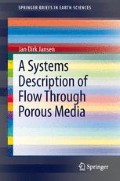Abstract
This chapter first treats the analytical solution of linear systems of ordinary-differential equations for single-phase flow. Next it moves on to the numerical solution of (nonlinear) two-phase flow equations, covering various aspects like implicit, explicit or mixed (IMPES) time discretizations and associated stability issues, Newton-Raphson iteration, streamline simulation, automatic time-stepping, and other computational aspects. The chapter concludes with simple numerical examples to illustrate these and other aspects such as mobility effects, well-constraint switching, time-stepping statistics, and system-energy accounting.
Access this chapter
Tax calculation will be finalised at checkout
Purchases are for personal use only
Notes
- 1.
- 2.
In practice, the computation of a matrix exponential should not be performed using this expression; see Moler and Van Loan (1978) for an overview of various possible methods.
- 3.
More precisely, the condition for asymptotic stability requires that all real parts of the eigenvalues are smaller than zero, a condition that is also referred to as the system matrix being Hurwitz. This condition is only of relevance if the eigenvalues are complex numbers, which implies that the system displays oscillatory behavior. However, because we don’t take inertia into account in the description of porous-media flow, the system cannot store kinetic energy and the pressures will only display exponentially decaying behavior. Correspondingly, the eigenvalues are real numbers and it suffices to require them to be negative-valued to guarantee asymptotic stability.
- 4.
However, instabilities in space do play a role in reservoir engineering, at least in theory. A well-known case is reservoir flooding with an unfavorable mobility ratio , i.e. with the mobility of the displacing fluid being lower than the mobility of the displaced fluid. In that case, a displacement front may become unstable such that viscous fingering takes place of the displacing fluid in the displaced fluid. Similar instabilities may occur when a heavy fluid is injected on top of a lighter one, which may lead to fingering caused by buoyancy-driven convection. In practice, geological heterogeneities often completely mask the fingering process.
- 5.
Eigenvectors are defined up to an arbitrary constant.
- 6.
I.e. an initial condition where not all grid-block pressures have identical values. The initial condition in Eq. (3.24) consists of spatial fluctuations around the initial reservoir pressure \( \overset{\lower0.5em\hbox{$\smash{\scriptscriptstyle\smile}$}}{p}_{R} = 30 \times 10^{6} \) specified in Table 1.1.
- 7.
Here we use the notation x(∞) to indicate \( \mathop {\lim }\limits_{x\, \to \,\infty } {\mathbf{x}}\left( t \right) \).
- 8.
A system where the states are influenced by future inputs is therefore referred to as non-causal .
- 9.
We use the shortcut notation x k to indicate x(t k ), i.e. the value of x at t = t k .
- 10.
The small number ε itself is often also called the convergence criterion. The state vector x may contain groups of elements with different physical dimensions (e.g. pressures and saturations), in which case the dimensions of ε are ill-defined. Moreover, the magnitudes of the pressures are usually much larger than those of the saturations (typically 106–107 versus 0–1) and therefore the pressure values determine whether or not the convergence criterion is met whereas the saturations have almost no influence. For multi-phase flow it is therefore required to specify separate convergence criteria for the pressures and the saturations, or to scale the variables such that they become dimensionless and of the same order of magnitude.
- 11.
The upper bound ∆t < −2/λ1 is also known as the CFL limit.
- 12.
In the more general case that A p is a continuous function of p, an iterative implicit solution using Picard or Newton iteration will be required.
- 13.
- 14.
In our case, where we neglected the diffusive effect of capillary pressures, the continuous form of the saturation equation is in fact completely convective. The spatial discretization brings back some numerical diffusion again.
- 15.
The moveable oil volume is equal to the pore volume times (1 – S wc – S or ).
References
Aziz K, Settari A (1979) Petroleum reservoir simulation. Applied Science Publishers, London
Batycky RP, Blunt MJ, Thiele MR (1997) A 3D field-scale streamline-based reservoir simulator. SPE Reserv Eng 12(4):246–254. doi:10.2118/36726-PA
Boyce W, Di Prima RC (2005) Elementary differential equations and boundary value problems, 8th edn. Wiley, New York
Bratvedt F, Gimse T, Tegnander C (1996) Streamline computations for porous media flow including gravity. Transp Porous Media 25(1):63–78. doi:10.1007/BF00141262
Chen Z, Huan G, Ma Y (2006) Computational methods for multiphase flows in porous media. SIAM, Philadelphia
Datta-Gupta A, King MJ (2007) Streamline simulation: theory and practice, SPE Textbook Series, 11. SPE, Richardson
King MJ, Datta-Gupta A (1998) Streamline simulation: a current perspective. In Situ 22(1):91–140
Luenberger DG (1979) Introduction to dynamic systems. Wiley, New York
Moler C, Van Loan C (1978) Nineteen dubious ways to compute the exponential of a matrix. SIAM Rev 20(4):801–836
Author information
Authors and Affiliations
Corresponding author
Rights and permissions
Copyright information
© 2013 The Author(s)
About this chapter
Cite this chapter
Jansen, J.D. (2013). System Response. In: A Systems Description of Flow Through Porous Media. SpringerBriefs in Earth Sciences. Springer, Heidelberg. https://doi.org/10.1007/978-3-319-00260-6_3
Download citation
DOI: https://doi.org/10.1007/978-3-319-00260-6_3
Published:
Publisher Name: Springer, Heidelberg
Print ISBN: 978-3-319-00259-0
Online ISBN: 978-3-319-00260-6
eBook Packages: Earth and Environmental ScienceEarth and Environmental Science (R0)

